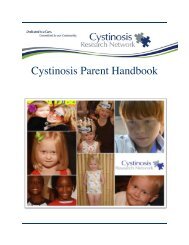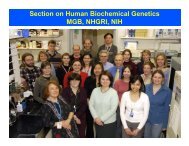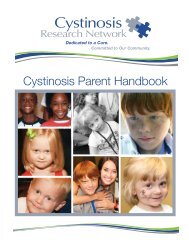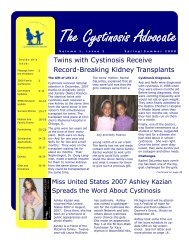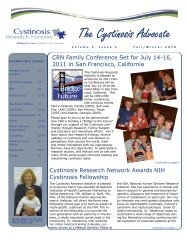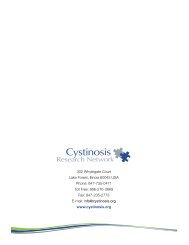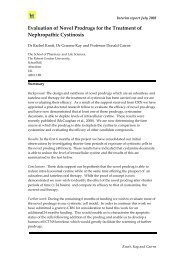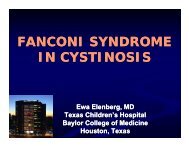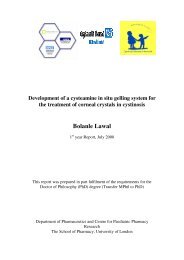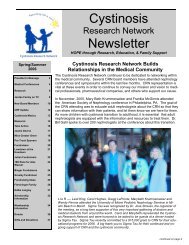Cystinosis Newsletter - Cystinosis Research Network
Cystinosis Newsletter - Cystinosis Research Network
Cystinosis Newsletter - Cystinosis Research Network
Create successful ePaper yourself
Turn your PDF publications into a flip-book with our unique Google optimized e-Paper software.
Page 7 The <strong>Cystinosis</strong> <strong>Research</strong> <strong>Network</strong> Fall/Winter 2006<br />
<strong>Cystinosis</strong> <strong>Research</strong> Update<br />
<strong>Cystinosis</strong> <strong>Research</strong> Update<br />
By Christy Greeley, Vice President, <strong>Research</strong><br />
2006 <strong>Research</strong> Funding Announced<br />
The CRN Scientific Review Board met in July 2006 to review the studies received from this year’s call<br />
for proposals. We are proud to announce that two grants have been funded as a result of the SRB’s<br />
recommendations. They are:<br />
“Study of ATP metabolism in human cystinotic proximal tubular cells<br />
and in humans with cystinosis in vivo”<br />
Elena Levtchenko, M.D., Ph.D., University Medical Center Nijmegen,<br />
The Netherlands<br />
Grant Timeline: January 2007 – December 2007<br />
Award Amount: $68,090<br />
<strong>Cystinosis</strong> is an autosomal recessive disorder with multi-organ involvement. The disease is caused by<br />
mutations in the CTNS gene, which maps to 17p13 and encodes the lysosomal cystine carrier, cystinosin.<br />
<strong>Cystinosis</strong> initially affects the kidneys and subsequently other organs including eyes, central<br />
and peripheral nervous system, muscles, endocrine organs and liver. The aminothiol, cysteamine, depleting<br />
intralysosomal cystine, retards the deterioration of renal function and postpones the occurrence<br />
of extra-renal complications. This is in agreement with increased lysosomal cystine levels being<br />
the primary cause of this disease. However, the subsequent steps in the pathogenesis of cystinosis<br />
are unknown. Alterations of intracellular energy metabolism were postulated to be an underlying<br />
mechanism of cellular dysfunction in cystinosis based on the finding of ATP depletion in proximal tubular<br />
cells loaded with cystine dimethyl ester. However, this mechanism was neither confirmed in human<br />
renal material nor in humans with cystinosis. The study of ATP metabolism in human cystinotic<br />
proximal tubular cells and in humans with cystinosis and controls is the subject of this research proposal.<br />
The project is based on (i) our initial observations that cystinotic fibroblasts and granulocytes display a<br />
significant decrease in intracellular ATP and (ii) development of differentiated human cystinotic proximal<br />
tubular cell lines, carrying known CTNS mutations, which cystine accumulation approaches the in<br />
vivo situation.<br />
Apart from this we will evaluate intracellular ATP status in vivo in patients with cystinosis using MR<br />
spectrometry.<br />
Therefore, the current study consists of both a fundamental part and a clinical part.<br />
A. The fundamental part focuses on:<br />
The investigation of ATP homeostasis in temperature sensitive immortalized proximal tubular cell lines<br />
from cystinotic patients and healthy controls at different stages of cystine accumulation and after exposure<br />
to cysteamine.<br />
B. The clinical part focuses on:<br />
Measurement of ATP status in vivo in patients with cystinosis.<br />
The demonstration of altered ATP homeostasis in human cystinotic proximal tubular cells and in humans<br />
with cystinosis will set a major step towards better understanding the pathogenesis of the disease<br />
and ultimately to develop new therapeutic strategies in patients with cystinosis.<br />
continued on page 8



